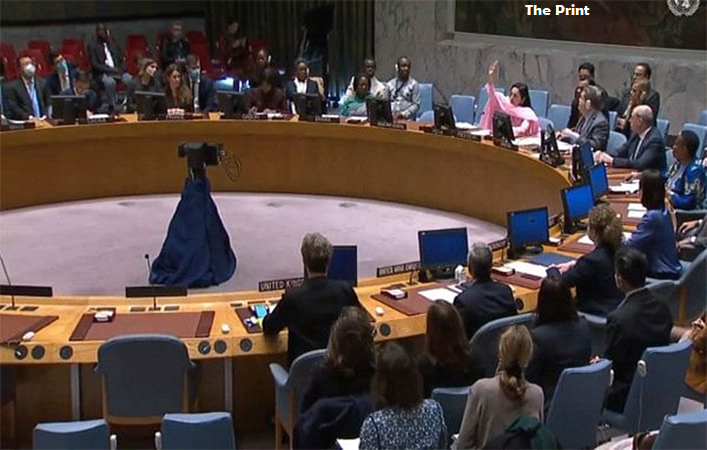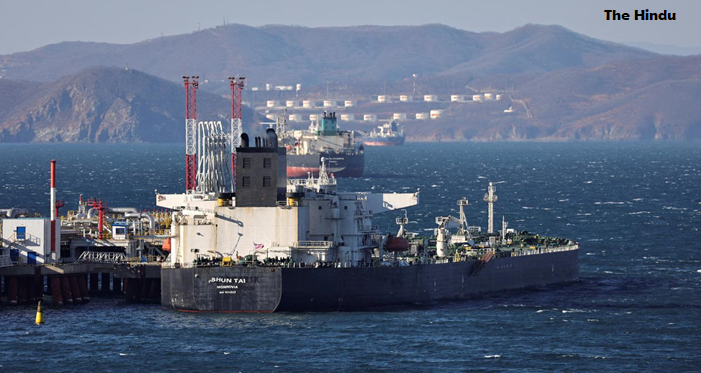At UNSC India abstains from vote on resolution that exempts humanitarian aid from sanctions (GS Paper 2, International Organisation)

Why in news?
- Recently, India has abstained from voting in United Nations Security Council (UNSC) on a resolution that exempts humanitarian aid efforts from sanctions.
- The draft resolution to exempt humanitarian aid efforts from sanctions and presented by the US and Ireland, was adopted by 14 members of the 15-member Council.
India’s stand:
- India’s concerns were triggered by proven instances of terrorist groups, including Pakistan-based terrorist groups Lashkar-e-Taiba and Jaish-e-Mohammed “taking full advantage of such humanitarian carve-outs and making a mockery of sanctions regimes.”
- Making a veiled reference to Pakistan, India said it will call for caution and due diligence be used when providing humanitarian aid to groups that are prohibited under UN Security Council Resolution 1267, who continue to thrive with full state hospitality in territories universally acknowledged as terrorist havens by the international community.
- India has requested the resolution to assure UN oversight of humanitarian exclusions, expertise in “robust reporting,” which was not completely addressed in the legislation, and sanctions.
What’s next?
- UNSC approved the resolution exempting humanitarian aid from all current and future UN sanctions regimes, a vote the United States hailed as “historic” that will save lives and address longstanding problems of sanctions impeding aid deliveries.
- The draft resolution was adopted-14 votes in favour, zero against and one absentation.
Will new drug slow progress of Alzheimer’s?
(GS Paper 3, Science and Tech)
Why in news?
- Recently, a drug, lecanemab, jointly developed by pharma companies Biogen and Eisai, was tested on patients with early Alzheimer’s.
- Results of the study presented at the Clinical Trials on Alzheimer’s disease conference in San Francisco, U.S., showed modest effects in arresting decline in cognitive and functional aspects in patients with early disease.
- This has sparked hope in a world where an estimated 55 million people live with the debilitating effects of Alzheimer’s disease.

What is lecanemab and how does it work?
- Lecanemab belongs to a class of drugs called monoclonal antibodies.
- These antibody-mediated drugs target beta amyloid, the protein deposition that is seen in patients with Alzheimer’s disease, and disrupts cells function.
- The clinical trial, conducted over 18-months, a multi-centre, double-blind, phase 3 trial, involved persons 50 to 90 years of age with early Alzheimer’s disease (mild cognitive impairment or mild dementia due to Alzheimer’s disease) with evidence of amyloid deposition.
- Participants were randomly assigned intravenous lecanemab or placebo. It was observed that lecanemab robustly removed the amyloid plaques.
- This was the primary end point of the trial, which showed a change in the score recorded at baseline when the trial began on the Clinical Dementia Rating–Sum of Boxes (CDR-SB).
- Key secondary end points included a change in amyloid burden on PET (positron-emission topography). There were changes both in the lecanemab group versus the placebo group.
Will lecanemab be the silver bullet to treat Alzheimer’s?
- A phase-3 trial showing efficacy on clinical outcomes is welcome news.
- However, the difference noticed on the CDR-SB scale may not be clinically meaningful, going by metrics indicated in previous studies.
- Also, the development of amyloid-related imaging abnormalities (ARIA) in one of five patients was a cause for concern.
- Ongoing trials are assessing the efficacy of subcutaneous administration and whether lecanemab can prevent onset of dementia in patients with amyloid pathology but no clinical symptoms. However, the immediate impact of lecanemab should not be overstated.”
What is the future?
- An initial decision on the drug’s approval by the FDA is expected by January 6, 2023, and from the European Medicines Agency later in 2023.
- But for now, the key public health message for Alzheimer’s disease remains that laid out in the 2020 Lancet Commission on dementia prevention, intervention, and care: target the modifiable risk factors for dementia such as hypertension, smoking, diabetes, and obesity, to maintain brain health across the lifespan.
What does a price cap for Russian oil mean?
(GS Paper 3, Economy)
Context:
- After months of negotiation, western countries comprising the Group of Seven nations, the European Union and Australia, agreed to a price ceiling of $60 per barrel of seaborne Russian Urals crude oil that came into force just as sanctions against freighters carrying Russian crude oil took effect recently.

Why did the West want a price cap?
- Western nations, led by the G-7, want to punish Russia for having invaded Ukraine and rein in the profits accruing to Russia from oil exports. But they also want to keep some oil from Russia flowing globally so that supply is not significantly affected, which could push up energy prices.
- With a recession in parts of the western world already a possibility, oil price spikes would only hasten the spiral into economic contraction.
- So western nations came up with the concept of a price cap, above which accessorial services such as ship insurance, vessel clearances and the like would not be available to freighters carrying Russian oil.
- About 95% of global insurance for freighters by tonnage comes from European countries, especially the United Kingdom. Without such services, Russia would find it difficult to sell its crude above the price cap.
How has Russia responded?
- Russia had first said the price cap might only impact its output minimally. Later, it also spoke about considering a ban on export to countries that insisted on the price cap.
- Deputy Prime Minister Alexander Novak has said that a mechanism was being worked out and that the ban on oil export to such countries would take effect before the year closed.
- Russia is also said to be considering a floor price in retaliation to the price cap, as another option. A floor price would aim to ensure that it did not sell below that level. This tug of war would theoretically put Russian oil buyers, who want European insurance and other services to continue, in a bind.
How has Russia’s oil output been this year?
- Between January and November, Russia’s production rose 2% to about 488 million tonnes, as per global media reports.
- China and India are popular examples of countries that bought discounted oil. But the likes of France and major oil producer Saudi Arabia too purchased oil from Russia.
- Saudi used the discounted price to buy oil to run its power plants, while selling its own costlier variant to the world.
- Recently, India’s External Affairs Minister cited the European Union’s oil imports from Russia as being six times as much as India’s between February 24 and November 17.
How much oil does India import from Russia?
- Interestingly, India whose imports of Russian oil was only about 0.2% of total oil imports in the year ended March 2022, has had Russia serve as its top oil supplier in October and November.
- In November, India bought 53% of all the seaborne Urals crude that Russia exported.




